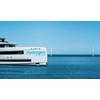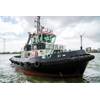DTF: Longer Workboat Engine Life Impacts Environment
New Research Doubles Service Life Estimate of Marine Workboat Engines, Reveals Big Opportunities for Diesel Emissions Reductions. New Research also Underscores Cost-Effective Opportunity to Upgrade to New Diesel Engines and Reduce Emissions for Vulnerable Communities.
Commercial workboat engines, which are essential for maritime commerce, are staying in service more than two times longer than predicted by the U.S. Environmental Protection Agency (EPA), according to new research from the Diesel Technology Forum (DTF) and Environmental Defense Fund (EDF). This finding reveals important opportunities for clean air improvements, especially in large port cities like New York and Houston.
DTF and EDF’s new report, “Impact of Updated Service Life Estimates on Harbor Craft and Switcher Locomotive Emission Forecasts and Cost-Effectiveness”, completed by Ramboll Environ, found the average Category 2 workboat remains in service for 50 years, instead of the 23-year lifespan estimated by the EPA in the 2008 Heavy Duty Locomotive and Marine Rule. A longer service life reduces the fleet’s turnover rate to cleaner, lower-emitting engines, therefore increasing future-year emission estimates.
The U.S. Army Corps of Engineers estimates that, as of 2014, there were approximately 9,000 Category 1 and 2 marine vessels operating on U.S. waters. The Category 2 workboats highlighted in the DTF and EDF report have displacements of 7 to 30 liters per cylinder and are installed primarily in larger workboats like pushboats, towboats or off-shore support vessels. These vessels provide a range of essential services in waterborne commerce including towing, harbor navigation, docking, supply and rescue, and recovery.
“Diesel engines are known and valued for their legendary durability; thanks to their unmatched combination of power, performance, efficiency and reliability, diesel engines are the technology of choice for marine workboats,” said Ezra Finkin, DTF Policy and Outreach Director. “This report underscores that more, older engines remain in service today. Since real-world workboat engines are operating with longer lifespans, the actual nitrogen oxide emission reductions are 52 percent weaker than predicted in EPA’s 2008 Rule calculations. Replacing more of these older and longer-lived engines with the latest clean diesel models, faster, will generate significant emissions reductions.”
The EPA estimates that, as of 2014, 81 percent of Category 1 and 2 workboats used older, uncontrolled or Tier 1 diesel engines, which are 10 times higher in emissions than a modern Tier 4 diesel engine. According to the DTF-EDF report, the slow turnover rate of these technologies means communities will only see nitrogen oxide (NOx) reductions of 161,167 tons per year, well below the 333,925-ton reduction predicted in the EPA 2008 Rule. Similarly, fine particulate emissions (PM 2.5) will only be reduced by 3,537 tons per year, instead of by 8,758 tons per year.
“Most tugs are operating in locations near America’s ports which do not meet current federal health-based air quality standards,” said Dr. Elena Craft, EDF Senior Director. “This study underscores the need to increase funding for the replacement of older marine engines, reduce exposure to diesel emissions, and for EPA to update the service life assumptions used by the 2008 Rule.”
Starting in 2015, new diesel engines used in marine applications in the United States were required to meet Tier 4 emissions standards. Relative to previous generations of technology, these latest clean diesel technologies are proven to dramatically reduce emissions, including nitrogen oxides and fine particulates, by 88 percent to 95 percent compared to previous generations.
Significant Emissions Reductions Opportunity: New York and Houston Examples
Despite the widespread availability of the new, cleaner diesel engines for workboats, the cost and downtime required to upgrade to new engines and other factors have likely delayed investments in the newest technologies.
“If the rate of turnover to the newest generation of diesel technologies can be accelerated, near-port communities stand to reap significant air quality benefits; it’s definitely low-hanging fruit on the clean air tree,” said Allen Schaeffer, DTF Executive Director. “For example, if all existing Category 2 vessels serving the New York Harbor upgraded to the newest diesel engines, emissions in the New York metropolitan area would be cut by more than 8 tons of nitrogen oxides per day. In the Port of Houston and Galveston, more than 4 tons of nitrogen oxides reductions per day could be realized for the Houston metropolitan area.”
State governments have an opportunity right now to replace old work boat engines with new ones, delivering significant and immediate emission reductions for surrounding communities, long before many other options. States can use funds from Volkswagen’s $2.9 billion environmental mitigation trust for marine repower projects.
A related study by DTF and EDF confirms that upgrading workboats to the newest-model clean diesel engines delivers the greatest emissions improvements for the lowest cost. Commercial marine engine upgrade or repower projects are very cost-effective owing to high engine rated power, hours of operation, engine load, and long service life. On average, upgrading the engines of a single tugboat to the newest diesel technologies eliminates 14.9 tons of nitrogen oxide emissions per year for only $4,379 per ton of nitrogen oxide eliminated. Compare this to the cost of many other types of nitrogen oxide -reduction projects: more than $30,000 per ton of nitrogen oxide.
“Large engine repowers are more than six times as cost effective on a dollar-per-ton-of-emissions-reduced basis than other projects, which should make for an easy and compelling choice for states in ozone non-attainment,” said Schaeffer. “The incentive funds give boat operators a brand new, more efficient, fuel-saving and lower-emitting engine at a fraction the cost. Even better, the emission benefits associated with these projects will accrue quickly and persist for many years.”














